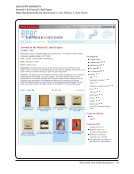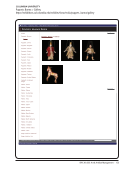100 · Representative Documents: Arrangement Guidelines
Library of Congress
Arrangement Schemes for Photographs
http://www.loc.gov/rr/print/tp/Arrangement%20Schemes%20for%20Photographs.pdf
p. 1 of 3
Arrangement Schemes for Photographs
Compiled by Brett Carnell, 2004
Prints &Photographs Division, Library of Congress, Washington, DC 20540-4730
This “how to” tip sheet outlines typical categories (also called series) for arranging photographs
within collections. A sample container list for a fictional collection illustrates the presentation of
the physical arrangement.
Typical series for photographs
Physical format is a frequent primary criterion for establishing photographic series. Original
order is often based on format distinctions, because material such as prints and slides have
different storage needs and uses even before they reach an archives. The archives might further
separate material by format, especially negatives, to ensure preservation of fragile material.
When only a few items are in a special format, references to separate storage locations can
suffice rather than establishing an entire series.
Photographic series listed in finding aids often appear to be subject based, because topical words
begin the series name. The primary criterion for such series, the physical format “prints,” is
implicit. Series for other formats such as negatives, albums, or cased photographs tend to have
the format term stated explicitly in the series name.
Within each format-based series, the subseries can rely on such “unifying elements” as function
or genre, subject, or chronology. Series may also be divided into file units or items based on
format such as a single album.
Examples:
Format-based series Prints
Negatives
Slides
Oversize
Function or Genre series Advertising photos
Book illustrations
Campaign photos
Exhibit prints
Landscapes
Portraits
Public affairs photos
Staff identification photos
Subject-based series People
Culture groups
Employee photos
Family members
Friends and acquaintances
Organizations
Library of Congress
Arrangement Schemes for Photographs
http://www.loc.gov/rr/print/tp/Arrangement%20Schemes%20for%20Photographs.pdf
p. 1 of 3
Arrangement Schemes for Photographs
Compiled by Brett Carnell, 2004
Prints &Photographs Division, Library of Congress, Washington, DC 20540-4730
This “how to” tip sheet outlines typical categories (also called series) for arranging photographs
within collections. A sample container list for a fictional collection illustrates the presentation of
the physical arrangement.
Typical series for photographs
Physical format is a frequent primary criterion for establishing photographic series. Original
order is often based on format distinctions, because material such as prints and slides have
different storage needs and uses even before they reach an archives. The archives might further
separate material by format, especially negatives, to ensure preservation of fragile material.
When only a few items are in a special format, references to separate storage locations can
suffice rather than establishing an entire series.
Photographic series listed in finding aids often appear to be subject based, because topical words
begin the series name. The primary criterion for such series, the physical format “prints,” is
implicit. Series for other formats such as negatives, albums, or cased photographs tend to have
the format term stated explicitly in the series name.
Within each format-based series, the subseries can rely on such “unifying elements” as function
or genre, subject, or chronology. Series may also be divided into file units or items based on
format such as a single album.
Examples:
Format-based series Prints
Negatives
Slides
Oversize
Function or Genre series Advertising photos
Book illustrations
Campaign photos
Exhibit prints
Landscapes
Portraits
Public affairs photos
Staff identification photos
Subject-based series People
Culture groups
Employee photos
Family members
Friends and acquaintances
Organizations


















































































































































































